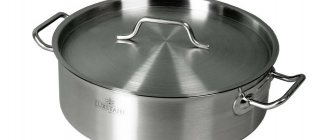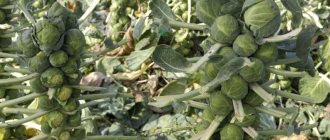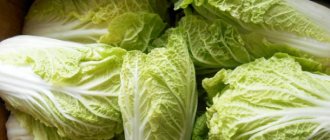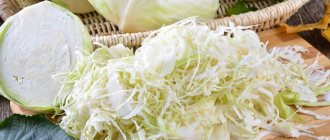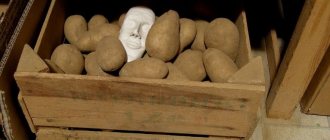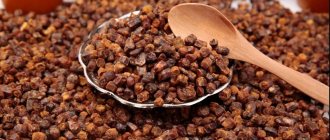Cauliflower contains many vitamins and microelements and is great for making soups, side dishes and other dishes. Let's consider how to store cauliflower at home so that it does not lose its taste and beneficial qualities. We will also tell you what rules you need to follow when growing crops in order to increase its keeping quality.
Only healthy, tight heads of cabbage are selected for storage.
Preparing heads of cabbage for long-term storage
Before storing, the crop must be sorted. Heads of cabbage with signs of spoilage and damage will not last long. High-quality cauliflower does not have any traces of rot or dark spots.
Fully ripened heads of cabbage should acquire some looseness. To begin with, they are cleaned by cutting off the roots and leaves. Further preparation depends on the storage method. For example, if you plan to keep cauliflower in the freezer, lightly boil it first.
Necessary storage conditions
The optimal storage temperature is 0-4° C, humidity is 85-90%. The shelf life is affected not only by the conditions and characteristics of the cabbage variety, but also by the degree of maturity. It is better not to let the vegetable overripe, otherwise its shelf life will decrease.
Interestingly, according to the previously approved GOST, cauliflower was supposed to be stored for 60 days under optimal conditions. A little later, regulations were adopted allowing storage for 80 days. This became possible due to the fact that breeders developed new varieties of crops with increased shelf life.
Harvesting
Even a novice gardener can grow and preserve cauliflower. This vegetable needs warmth, regular watering and fertilizing, but it is better to avoid direct exposure to the sun.
The traditional harvest time is from July to early August, but the characteristics of the variety play a role here. The quality and degree of preservation of the vegetable depends on the literacy of harvesting.
- cut off the inflorescences when they reach 10-15 cm in diameter;
- a ripe vegetable needs to be immediately removed from the garden;
- a tool for cutting the heads is a sharp knife: the inflorescence is grabbed along with the lower leaves;
- It is correct to store cauliflower, just picked and fresh, in a dark and cool place.
If weather conditions require immediate removal of seedlings from open soil, transplant them into a greenhouse or cellar to grow there.
Which varieties are best stored?
When choosing a variety for planting, you should pay attention to the length of the growing season, since the shelf life of the crop depends on this indicator. Early varieties of cauliflower are usually grown for quick consumption; even in suitable conditions, this vegetable will last no more than 2 weeks. And such cabbage ripens early, already in June.
Such a vegetable will not be able to survive until spring under any conditions, excluding freezing. Mid-season and late varieties ripen in 120-150 days. Their shelf life indicators are approximately the same, only the ripening time differs. Late varieties are most suitable for winter storage.
Storage methods
To preserve the cauliflower harvest, summer residents resort to various tricks. The easiest way is to place vegetables in the refrigerator, but this is not always convenient, so other places are used.
In a refrigerator
Before storing cabbage, they are disassembled into inflorescences. There is no point in taking up extra space in the refrigerator by placing the heads of cabbage there along with the stalk. Cauliflower is considered sissy and does not store as well as other varieties. To prolong its preservation, it needs a special approach.
The prepared inflorescences are washed and dried, spread out in 1 layer. Then they are wrapped in cling film or placed in a plastic bag. After this, several small holes are made in the package using a toothpick so that air can flow inside. You can put the inflorescences in a glass jar, the neck of which is then covered with parchment paper. You need to keep vegetables in the refrigerator on the bottom shelf or in the compartment designated for this purpose.
In the freezer
Storing in the freezer is the only way to extend the life of fresh cauliflower for a whole year. Store the workpiece in the usual way, placing it in portions in bags or plastic containers. In winter, the inflorescences are added according to the recipe to any dish or simply heated and eaten.
In the cellar
You can successfully preserve vegetables in a cold cellar. Here the heads of cabbage are placed, hanging by the stalk at some distance from one another. You can arrange the cabbage in boxes, covering the top with a sheet of cardboard or polyethylene. It is necessary to periodically monitor the condition of the vegetable, removing spoiled specimens.
We recommend: Is it possible to store sourdough, dough and finished bread in the refrigerator?
In sand
The vegetable will last longer if you bury the heads of cabbage with their roots in moistened sand. The roots will absorb moisture during storage, as a result the cabbage will remain fresh longer. The heads of cabbage should not be placed closely; a gap of several centimeters should be left between them.
In clay
This method does not require pre-cleaning the heads of cabbage. They are coated with clay, diluted to a semi-liquid consistency, and allowed to air dry. After this, the cabbage is removed to the basement or cellar, where it is simply laid out on racks.
Paper wrapping
Paper is highly breathable, making it suitable as a packaging material. Heads of cabbage wrapped in it do not lose moisture and are protected from temperature fluctuations. Each head of cabbage must be wrapped separately. After this, the cabbage is laid out in a cool place at a temperature of 0-4 ° C, so it will be stored for several months.
On the balcony
If the balcony is not glazed, you can store cabbage on it only until frost sets in. Later you will have to look for another cool place. On a glazed balcony it is better to build a box with insulated walls and bottom. You can store heads of cabbage in it, wrapped in paper or coated with clay. In severe frost, you will need to additionally cover the box with an old blanket or outerwear (padded jacket, jacket).
Growing up
This method will allow you to keep the cabbage really fresh, since the growth processes in it will continue, albeit at a slower pace. Typically, growing is used when the crop had to be harvested prematurely due to bad weather.
Heads of cabbage can be grown in a cellar or basement, where the temperature does not rise above +4° C and does not drop to negative values. You will need to prepare boxes with garden soil in advance. Before transplanting for growing, cabbage is watered abundantly.
After a couple of days, the heads of cabbage are dug up along with a lump of earth and transferred to boxes, laid close together. You will need to dig the cabbage all the way down to the leaves. It is necessary that the temperature in the utility room is kept at 0-4° C and the humidity is 90-95%. It is also important to ensure a good level of ventilation.
Storage tips and tricks
To summarize, we can give the following recommendations that will be useful to people who decide to stock up on this vegetable crop for the winter:
- The reason for spoilage of reserves, even if all requirements and conditions are met, may be the abuse of potassium fertilizers applied to garden soil. To minimize this risk, it is recommended to stop using them several weeks before the planned harvest.
- It is not recommended to store heads of cabbage with even the slightest direct contact between them, as this can trigger the process of rotting.
- During storage, it is necessary to avoid frequent changes in temperature , otherwise the heads of cabbage will gradually turn black and acquire a bitter taste, which will make them unsuitable for consumption.
- Freezing can be done only once; repeating this process will spoil the supplies: upon subsequent defrosting, they will become like porridge.
- When storing in the refrigerator, supplies must be placed as far as possible from the freezer , it is best if they are located in close proximity to the vegetable compartment.
Shelf life of cauliflower
The shelf life of cauliflower depends on the conditions created, proper preparation and packaging of the heads. The harvest of mid-season and late varieties that are not overripe will last the longest:
- at home (outside the refrigerator) – several days;
- in the refrigerator - from 2 to 4 weeks;
- in the freezer – up to 1 year;
- in a cellar or basement - 2-3 months;
- during growing – six months.
Storing in a plastic bag speeds up the spoilage process, since due to lack of ventilation, cabbage can become moldy and rot. If the heads of cabbage are not white, but cream-colored, this indicates that they are overripe. The vegetable loses its elastic consistency and, as a result, is also stored less. An excess of nitrogen fertilizers during the growing process also contributes to a decrease in keeping quality.
Alternative Methods
If you can't keep your cauliflower cool, you can consider alternative ways to store it. The product can be canned or dried.
Drying
During the drying process, cauliflower loses some of its beneficial properties, and its taste also deteriorates. However, sometimes this is the only way to preserve the product, for example, if you have to process the crop in the country and it is not possible to provide the vegetable with cool conditions.
You can dry cabbage in different ways:
- in the oven;
- in an electric dryer;
- in an air fryer.
Drying is carried out at a temperature of 55-60° C. Drying time for cabbage depends on the equipment used. Readiness can be determined by the color fading. The degree of drying should be such that the cabbage retains its elasticity, but at the same time appears dry to the touch. If the product crumbles in your hands, it has been overexposed.
We recommend: How long can you store potatoes in the refrigerator?
The accelerated method involves using a microwave, but you must act carefully so as not to spoil the workpiece. Drying is carried out in 3-4 steps. The bowl with the raw materials is periodically taken out, the cabbage slices are mixed, and then put back in the oven. The finished product is placed in a glass jar and covered with a lid. Store the workpiece in a dark, dry place at room temperature.
Canning, pickling
You can make many preparations for the winter from cauliflower. It is canned, pickled, and fermented. The vegetable can be used as part of an assortment, rolled into jars along with cucumbers, tomatoes, sweet peppers, and carrots. Cauliflower marinated with beets is very tasty.
The inflorescences are painted a pleasant pink color and receive additional benefits:
- For 1 kg of cauliflower, take 1 beet, cut into thin slices.
- Bay leaves, garlic cloves, cabbage inflorescences along with beets are placed in sterilized jars.
- Pour boiling water over the vegetables and leave for 15 minutes.
- After this, pour the water into a saucepan, add salt and sugar to taste, pour in vinegar (3 teaspoons per 1 liter of water) and bring to a boil.
- The cooked marinade is poured into jars and immediately closed with sterilized screw caps.
You can store this product at room temperature in the pantry. If possible, jars with blanks are lowered into the basement, where storage conditions are even more favorable.
Common Mistakes
The most important mistake is storing heads of cabbage that are least suitable for this purpose. It may be an overripe or spoiled product. Thrifty housewives try to preserve the entire harvest, but cabbage of less than ideal quality will still not last long.
When stored in a cellar or basement, heads of cabbage are sometimes piled into one large pile; this should not be done. Cauliflower has a delicate texture and requires careful handling. The heads of cabbage must be laid out so that they do not touch each other or hung by the stalk.
Sometimes cauliflower is chopped before storing in the refrigerator to store it more compactly. In this case, the vegetable spoils faster and loses its taste. Grinding is only permissible if the product is frozen or dried. When storing in the freezer, the product must not be re-frozen, otherwise the cabbage will turn into a shapeless mass that has lost its taste.
How else can you save vegetables for the winter?
Another option for obtaining fresh vegetables for winter is growing. This method can be used if the forks have not yet matured to the required size by the time of harvest. Rearing is carried out as follows:
- a few days before harvesting, the cabbage must be watered generously;
- Dig up the heads of cabbage with roots and an adjacent lump of earth;
- in the basement, prepare earthen beds by filling the boxes with soil, and plant plants tightly in them, filling them with soil to the level of the lower leaves;
- The soil should be watered as needed.
The room temperature should be maintained at 1-2°C and frequent ventilation should be provided to prevent high humidity levels. During the growing period, which can last up to 6 months, the forks reach the required size and retain their taste.
The beneficial substances contained in cauliflower can be obtained not only immediately after harvest, but also after a long time. Subject to temperature and light conditions, as well as acceptable humidity levels, the vegetable can be stored in the refrigerator, cellar or basement.
Answers on questions
Questions about storing cauliflower mainly come down to how to ensure that the product does not lose its visual appeal and taste. It becomes a pity when the grown cabbage begins to disappear.
How to preserve it so that it does not darken or spoil?
During long-term storage, it is very important to maintain constant temperature and humidity levels. Due to temperature changes, the heads of cabbage instantly darken, and bitterness may appear in the taste.
If this happens, it will be impossible to return the cabbage to freshness. Salt will additionally help protect the vegetable during storage. The inflorescences are placed in a glass jar, sprinkled with salt crystals. Salt absorbs excess moisture, thereby maintaining air humidity in a stable state.
How to freeze correctly?
The head of cabbage must first be disassembled into inflorescences, which are washed to remove debris and insects, and then blanched for 3 minutes and cooled using ice water. Next, you can cut the cabbage for compact storage. But still, it is better to leave the inflorescences whole, this way they are guaranteed to retain their taste and look more appetizing.
The rules for storing cauliflower may not be so easy to follow. However, this is the only way to maintain the freshness and quality of the product. Periodically it is necessary to check the condition of the heads of cabbage, removing moldy or rotten specimens. Do not use spoiled cabbage for cooking. The putrid smell cannot be masked by the use of spices and sauces, and the taste of the food will be spoiled.
Where and in what container to store
The choice of container directly depends on the location and storage method. It is inconvenient to put a wooden box in the refrigerator or lay out bags on the shelves of the cellar. Let's figure out how you can preserve cauliflower for the winter at home in different ways. At the same time, we will select packaging and containers for each occasion.
In the freezer
A simple, convenient storage method is freezing. At a temperature of -15 degrees, cauliflower will last well for a whole year. Bonus: maximum retention of nutrients. It is not advisable to freeze raw inflorescences; stick a whole head of cabbage into the freezer. Fish the right way.
Instructions for freezing cauliflower:
- We disassemble the inflorescences and immediately boil a pan of water.
- We omit the product. Bring to a boil over high heat, then reduce slightly. Boil for 3-4 minutes.
- Remove with a slotted spoon. Immediately pour into a bowl of cold water.
- Next, lay it out on a towel and let it dry. You need to get rid of excess moisture.
- Now we pack it into bags and freeze it.
- Or place it loosely on a baking sheet and freeze the pieces. Then we pack it. In this case, the product does not stick together.
When cooking cauliflower, you can add a pinch of citric acid or a little sugar to the water. They will improve the taste and help maintain a light shade.
You don't have to freeze just the cauliflower. You can immediately make vegetable mixtures with bell peppers, zucchini, eggplant, and tomatoes. Such preparations greatly simplify cooking in winter.
In a refrigerator
The refrigerator temperature is not very suitable for this vegetable. It ranges from +3 to +8 degrees. Often rises when the door is opened. Within a week, darkened areas and spots appear. We'll tell you how you can keep cauliflower fresh a little longer.
Step-by-step instruction:
- We clear the foliage, cut off the damage, and renew the stalk cut. We don’t cut it off completely.
- Place in a thin plastic bag. Let's tie it up.
- We make holes in different places for air exchange. Otherwise the head of cabbage will rot.
- Choose the coldest shelf. The temperature is not always lower in the vegetable compartment. Depends on the refrigerator.
- We place it closer to the wall so that the product is not blown by warm air from the door.
The worst thing to store in the refrigerator is a cut head of cabbage or separated inflorescences. They will not last more than 2-3 days. It makes more sense to blanch it after cutting and put it in the freezer.
Methods for storing cauliflower
In the cellar
Basements of private houses and high-rise buildings are not suitable. In them the temperature often rises above +7 degrees. Color heads do well in the 0 to +3 range. The second important point is that it is necessary to maintain high humidity in the region of 70-85%. Then the vegetable will not dry out. With an increase from 90% it can rot.
Basement storage methods:
- low wooden boxes. The vegetable is placed in one layer with the inflorescences facing up. Boxes can be stacked on top of each other. There should be holes between them for free air circulation;
- newspapers. Wrap each fork of cauliflower individually. Further storage is carried out on ordinary shelves, racks, depending on the filling of the cellar;
- plastic boxes. Place a layer of sawdust on the bottom and cover it with paper. Lay out exactly one layer;
- hanging. For this storage method, leave a long stalk. We tie a rope and hang it on the crossbar. Hooks on the ceiling will do. The cauliflower should not touch the wall.
Corrugated cardboard boxes are not suitable. Do not use metal objects for storage. If necessary, cover the shelves with cardboard sheets, canvas, lay sheets of thin plywood, chipboard.
The room must have ventilation or be ventilated periodically.
On the balcony
Residents of apartments do not have cellars. But there are balconies and loggias. You will have to adapt these places for storage. Additionally, you will need a box made of plywood boards. Sometimes they use an old cabinet or another piece of furniture.
Storage instructions:
- We line the box with foam plastic or another type of insulation.
- Place selected cauliflower.
- Close it and leave it.
A significant disadvantage of this storage method is that it is necessary to constantly monitor the temperature. On a hot day, open the drawer. When frost sets in, additional insulation is required.

